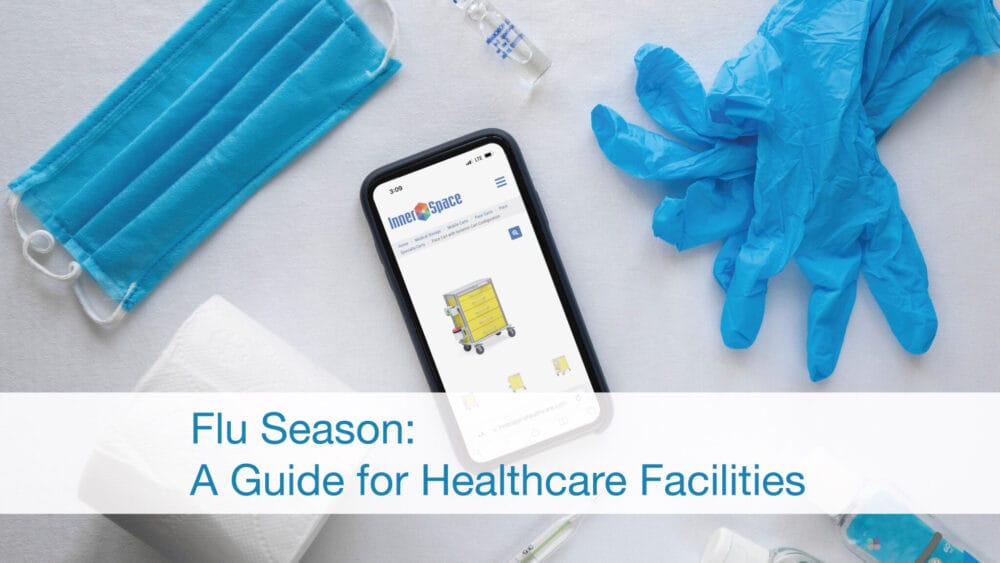
Flu season is a busy time for the healthcare industry. Now that COVID has joined the ranks of seasonal respiratory viruses, healthcare leaders are responsible for implementing strict policies to keep patients, visitors, and staff safe.
Read on for tips on how healthcare facilities can prepare for flu season and set up systems that help keep patients, staff, and visitors safe.
Promote Vaccines
Offer the influenza vaccine to staff and patients as soon as it is available. Unless contraindicated, offer the flu vaccine to all patients and staff over the age of 6 months.
Provide incentives to encourage staff to get vaccinated:
- Offer no-cost vaccines for staff and their family members
- Provide convenience by offering vaccine clinics during all shifts
Make Workflow Adjustments
The second line of defense against the spread of respiratory viruses is to make it harder for the virus to spread in your facility.
- Use physical barriers to stop the virus from traveling from person to person. Mount sneeze guards and clear dividers to act as barriers between patients and staff.
- Reroute the flow of patients and visitors to help people keep their distance from others. Consider a temporary change in workflows to prevent staff from congregating in one area.
- Use negative pressure isolation rooms for aerosol-producing procedures, such as intubations and breathing treatments.
- If community levels of respiratory illnesses are trending up, consider limiting elective procedures to free up resources that may be needed, such as ventilators and monitors.
Educate Visitors
Before flu season begins, add information to your public website, patient portals, and newsletters to educate patients about influenza:
- Signs and symptoms of influenza
- How RSV and COVID can be mistaken for the flu
- When to call their provider
- How to reduce their chance of getting sick
- How to keep from spreading the virus to their loved ones
Let visitors know what to expect when visiting your facility, such as mask mandates or screening procedures.
Update Policies for Patients and Visitors
Have clear expectations for visitors and patients. Provide the following information during appointment scheduling:
- Availability of the flu vaccine
- Screening procedures for visitors and patients
- Mask policy
- Number of people that can accompany patients to appointments
- Education on reducing the transmission of viruses:
- When to wear a mask
- Coughing and sneezing etiquette
- When to reschedule an appointment
Do not penalize patients who cancel appointments due to illness. Offer ill patients a telehealth appointment or transfer them to a triage nurse if they are at risk for severe complications.
When patients and visitors arrive at your facility, supply them with masks and hand sanitizer. Post educational posters reminding patients of good respiratory hygiene and proper hand-washing techniques.
Ask patients during check-in about any current symptoms, recent illness, or exposure to sick friends or family members.
Consider providing a separate waiting area for anyone experiencing symptoms of a respiratory virus.
Update Policies for Healthcare Workers
Provide education to your healthcare workers on how to stay well, what to do when they are sick, and free testing should they experience symptoms.
Lenient sick policies prevent staff from feeling that they need to work when ill. Assure your staff that there will be no repercussions for staying home when sick. And educate them on when to return to work, usually after they are fever-free for 24 hours and symptoms have resolved.
Personal protective equipment (PPE) protects staff and patients. Provide regular, mandatory training on when and how to use PPE, and ensure you have adequate PPE – and PPE storage – for a severe flu season.
Use Employee Health Services
Employee health services can help manage staffing levels by:
- Keeping track of ill employees
- Providing telehealth appointments to staff
- Training staff on the use of PPE and staying healthy
- Training ancillary staff on appropriate cleaning and disinfecting techniques and how to protect themselves
Update Patient Care Policies
Strategic planning can help reduce the risk of viral transmission in inpatient care areas:
- Designate separate areas for patients diagnosed with influenza.
- Use droplet precautions when caring for patients for seven days after the onset of flu symptoms and until 24 hours after their fever resolves.
- Require masks when staff is in the same room as a patient with flu symptoms.
- Place a mask on patients during transfers.
- Limit patient transfers and viral transmission risk by bringing procedures to the bedside.
- Assign isolation carts to one patient at a time and disinfect them before reuse.
- Invest in high-quality accessory products to keep work areas clean, such as glove box holders, disinfectant holders, and sharps containers.
- Consider investing in products designed to reduce bioburden, such as medical carts with antimicrobial drawer pulls and work surfaces.
Start planning early to promote a safe environment for staff, visitors, and patients. Even if you didn’t have a solid plan going into flu season, it isn’t too late to set up policies and procedures to keep the flu and other respiratory viruses from getting the upper hand in your healthcare facility.

Cindy Blye
Content WriterCindy Blye, BSN, RN, CCM is a Registered Nurse and Certified Case Manager. She is an Alumni of West Virginia University School of Nursing (BSN), and a member of the Association of Health Care Journalists and The Authors Guild.
